long Citroen JUMPY 2016 2.G User Guide
[x] Cancel search | Manufacturer: CITROEN, Model Year: 2016, Model line: JUMPY, Model: Citroen JUMPY 2016 2.GPages: 595, PDF Size: 12.47 MB
Page 111 of 595

109
Jumpy _en_Chap03_ergonomie-et-confort_ed01-2016
Work tableIf fitted to your vehicle, the backrest of the
bench centre seat tips for ward to form a
pivoting work table, creating a mobile office
(when stationary).
F
P
ull the grip at the top of the backrest. Never use the table while driving.
An object on the table could turn in to
a projectile and cause injuries under
heavy braking or in the event of an
impact.
Centre seat storage
F Pull the strap for ward to tip the seat cushion.
Ensure that the size, shape and volume
of loads carried are compatible with
the driving and safety regulations and
do not compromise the driver's field of
vision.
Lash all loads appropriately, to prevent
or limit their movement and avoid the
risk of injury.
Install the non-slip net (supplied with
the vehicle) every time the seat is raised
and the partition flap removed.
Do not use the net for other purposes.
Check the condition of the non-slip
net regularly. Replace it when it shows
signs of wear or tears, going to a
CITROËN to obtain a replacement
non-slip net to the specification and
quality defined by CITROËN for your
vehicle.
Refit the flap in the partition when no
longer carrying a long load.
3
Ease of use and comfort
Page 120 of 595
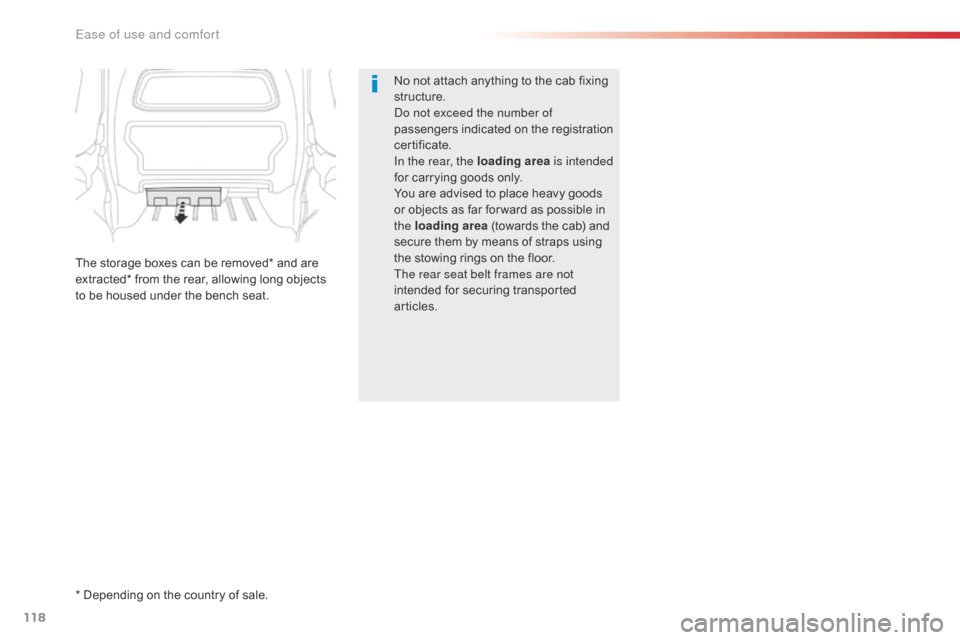
118
Jumpy _en_Chap03_ergonomie-et-confort_ed01-2016
No not attach anything to the cab fixing
structure.
Do not exceed the number of
passengers indicated on the registration
certificate.
In the rear, the loading area is intended
for carrying goods only.
You are advised to place heavy goods
or objects as far for ward as possible in
the loading area (towards the cab) and
secure them by means of straps using
the stowing rings on the floor.
The rear seat belt frames are not
intended for securing transported
articles.
The storage boxes can be removed* and are
extracted* from the rear, allowing long objects
to be housed under the bench seat.
* Depending on the country of sale.
Ease of use and comfort
Page 127 of 595
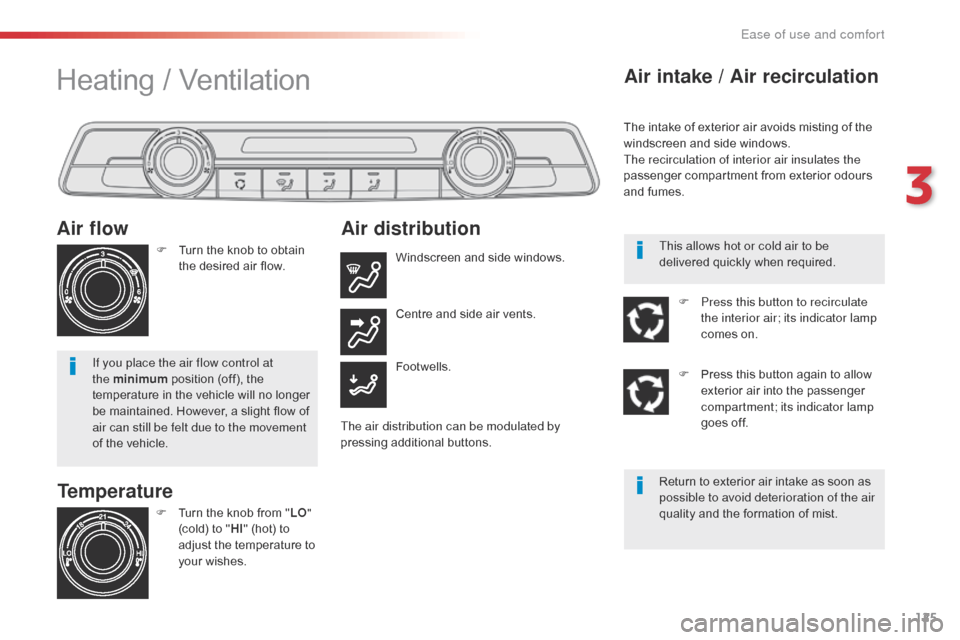
125
Jumpy _en_Chap03_ergonomie-et-confort_ed01-2016
Temperature
Air flow
F Turn the knob to obtain
the desired air flow.
If you place the air flow control at
the minimum position (off), the
temperature in the vehicle will no longer
be maintained. However, a slight flow of
air can still be felt due to the movement
of the vehicle.
Heating / Ventilation
F Turn the knob from " LO"
(cold) to " HI" (hot) to
adjust the temperature to
your wishes.
Air distribution
Windscreen and side windows.
Footwells. Centre and side air vents.
The air distribution can be modulated by
pressing additional buttons.
Air intake / Air recirculation
The intake of exterior air avoids misting of the
windscreen and side windows.
The recirculation of interior air insulates the
passenger compartment from exterior odours
and fumes.
Return to exterior air intake as soon as
possible to avoid deterioration of the air
quality and the formation of mist. This allows hot or cold air to be
delivered quickly when required.F
P
ress this button to recirculate
the interior air; its indicator lamp
comes on.
F
P
ress this button again to allow
exterior air into the passenger
compartment; its indicator lamp
goes off.
3
Ease of use and comfort
Page 128 of 595

126
Jumpy _en_Chap03_ergonomie-et-confort_ed01-2016
The air conditioning system only operates with the engine running.
Manual air conditioning
Temperature
F Turn the knob from "LO"
(cold) to " HI" (hot) to
adjust the temperature to
your requirements.
Air flow
F Turn the knob to obtain a comfortable air flow.
If you put the air flow control in the
minimum position
(system off), the
temperature is no longer controlled.
However, a slight flow of air can still be
felt, resulting from the movement of the
vehicle.
Air distribution
Windscreen and side windows.
Footwells. Central and side vents.
The air distribution can be adapted by adding
the corresponding buttons.
Air intake / Air recirculation
The intake of exterior air avoids misting of the
windscreen and side windows.
The recirculation of interior air insulates the
passenger compartment from exterior odours
and fumes.
Return to exterior air intake as soon as
possible to prevent deterioration of the
air quality and the formation of mist. This allows hot or cold air to be
delivered quickly when required.F
P
ress this button to recirculate
the interior air; its indicator lamp
comes on.
F
P
ress this button again to allow
exterior air into the passenger
compartment; its indicator lamp
goes off.
Ease of use and comfort
Page 133 of 595

131
Jumpy _en_Chap03_ergonomie-et-confort_ed01-2016
Switching the system off
F Press this button until the fan symbol disappears.
This action switches off all of the functions of
the system.
The temperature is no longer controlled. A
slight flow of air, resulting from the movement
of the vehicle, remains perceptible however. Avoid driving for too long with the
system switched off (risk of misting and
of deterioration of the air quality).
Air intake / Air recirculation
The intake of exterior air avoids misting of the
windscreen and side windows.
The recirculation of interior air insulates the
passenger compartment from exterior odours
and smoke.
Return to exterior air intake as soon as
possible to avoid deterioration of the air
quality and the formation of mist.This allows hot or cold air to be
delivered quickly when required.
F
P
ress this button to recirculate
the interior air; the symbol
appears.
F
P
ress this button again to allow
exterior air into the passenger
compartment; the symbol
disappears. F
P
ress this button to switch the
system on again.
3
Ease of use and comfort
Page 141 of 595
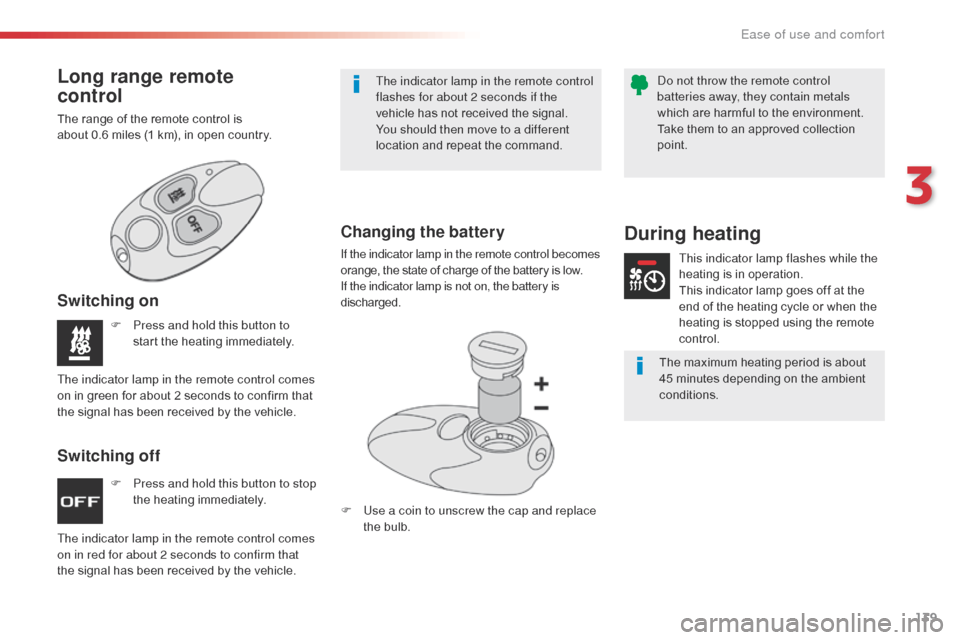
139
Jumpy _en_Chap03_ergonomie-et-confort_ed01-2016
F Press and hold this button to stop the heating immediately.
F
P
ress and hold this button to
start the heating immediately.
The indicator lamp in the remote control comes
on in red for about 2 seconds to confirm that
the signal has been received by the vehicle. The indicator lamp in the remote control comes
on in green for about 2 seconds to confirm that
the signal has been received by the vehicle.
Switching off Switching on
Long range remote
control
The range of the remote control is
about 0.6 miles (1 km), in open country. The indicator lamp in the remote control
flashes for about 2 seconds if the
vehicle has not received the signal.
You should then move to a different
location and repeat the command.
Changing the battery
If the indicator lamp in the remote control becomes
orange, the state of charge of the battery is low.
If the indicator lamp is not on, the battery is
discharged.
F
U
se a coin to unscrew the cap and replace
the bulb.
During heating
This indicator lamp flashes while the
heating is in operation.
This indicator lamp goes off at the
end of the heating cycle or when the
heating is stopped using the remote
control.
The maximum heating period is about
45
minutes depending on the ambient
conditions.
Do not throw the remote control
batteries away, they contain metals
which are harmful to the environment.
Take them to an approved collection
point.
3
Ease of use and comfort
Page 150 of 595
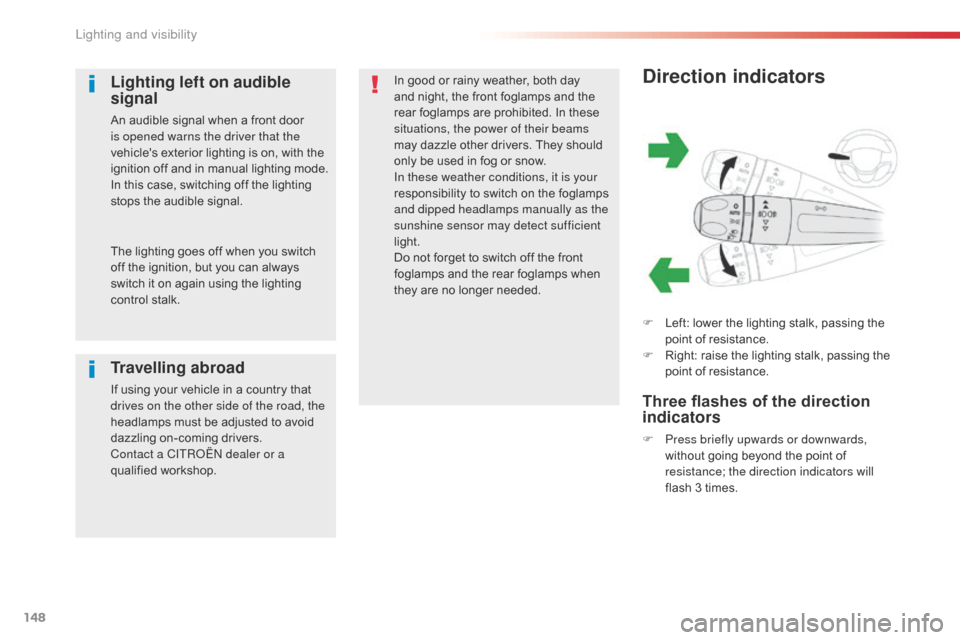
148
Jumpy _en_Chap04_eclairage-et-visibilite_ed01-2016
Direction indicators
F Left: lower the lighting stalk, passing the point of resistance.
F
R
ight: raise the lighting stalk, passing the
point of resistance.
Three flashes of the direction
indicators
F Press briefly upwards or downwards, without going beyond the point of
resistance; the direction indicators will
flash 3 times.
In good or rainy weather, both day
and night, the front foglamps and the
rear foglamps are prohibited. In these
situations, the power of their beams
may dazzle other drivers. They should
only be used in fog or snow.
In these weather conditions, it is your
responsibility to switch on the foglamps
and dipped headlamps manually as the
sunshine sensor may detect sufficient
light.
Do not forget to switch off the front
foglamps and the rear foglamps when
they are no longer needed.
Lighting left on audible
signal
An audible signal when a front door
is opened warns the driver that the
vehicle's exterior lighting is on, with the
ignition off and in manual lighting mode.
In this case, switching off the lighting
stops the audible signal.
Travelling abroad
If using your vehicle in a country that
drives on the other side of the road, the
headlamps must be adjusted to avoid
dazzling on-coming drivers.
Contact a CITROËN dealer or a
qualified workshop. The lighting goes off when you switch
off the ignition, but you can always
switch it on again using the lighting
control stalk.
Lighting and visibility
Page 151 of 595
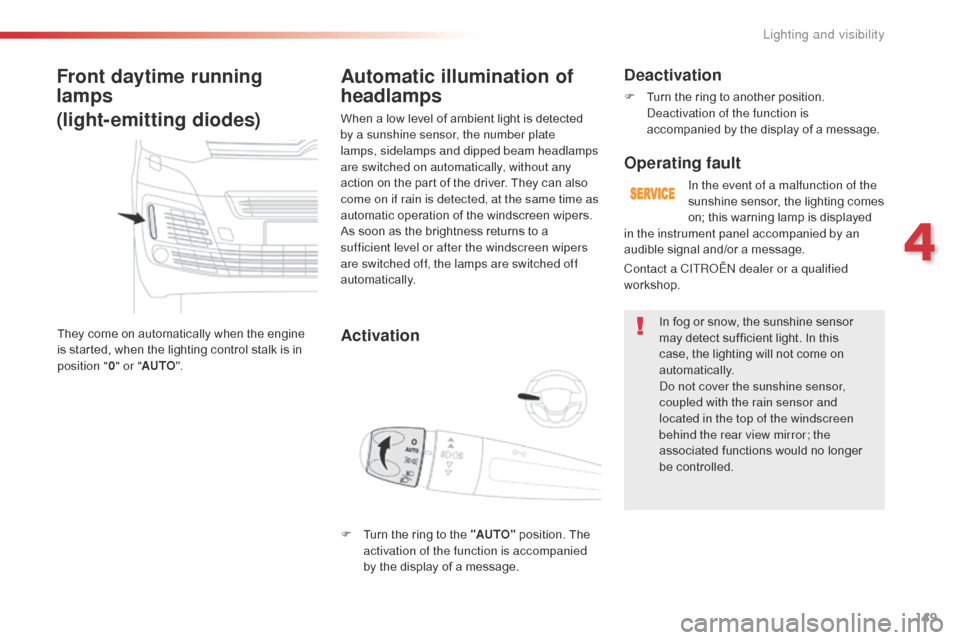
149
Jumpy _en_Chap04_eclairage-et-visibilite_ed01-2016
Front daytime running
lamps
(light-emitting diodes)
They come on automatically when the engine
is started, when the lighting control stalk is in
position "0" or " AUTO ".
Automatic illumination of
headlamps
Activation
When a low level of ambient light is detected
by a sunshine sensor, the number plate
lamps,
sidelamps and dipped beam headlamps
are switched on automatically, without any
action on the part of the driver. They can also
come on if rain is detected, at the same time as
automatic operation of the windscreen wipers.
As soon as the brightness returns to a
sufficient level or after the windscreen wipers
are switched off, the lamps are switched off
automatically.
Deactivation
F Turn the ring to another position. Deactivation of the function is
accompanied by the display of a message.
Operating fault
In the event of a malfunction of the
sunshine sensor, the lighting comes
on; this warning lamp is displayed
Contact a CITROËN dealer or a qualified
workshop. in the instrument panel accompanied by an
audible signal and/or a message.
In fog or snow, the sunshine sensor
may detect sufficient light. In this
case, the lighting will not come on
automatically.
Do not cover the sunshine sensor,
coupled with the rain sensor and
located in the top of the windscreen
behind the rear view mirror; the
associated functions would no longer
be controlled.
F
T
urn the ring to the "AUTO" position. The
activation of the function is accompanied
by the display of a message.
4
Lighting and visibility
Page 155 of 595
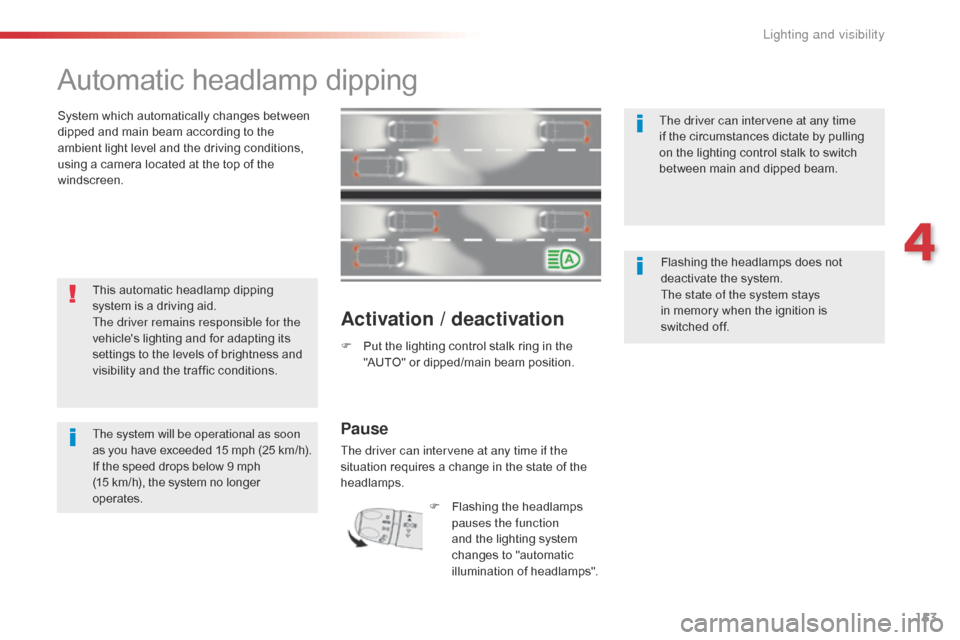
153
Jumpy _en_Chap04_eclairage-et-visibilite_ed01-2016
Automatic headlamp dipping
System which automatically changes between
dipped and main beam according to the
ambient light level and the driving conditions,
using a camera located at the top of the
windscreen.
Activation / deactivation
F Put the lighting control stalk ring in the "AUTO" or dipped/main beam position.
This automatic headlamp dipping
system is a driving aid.
The driver remains responsible for the
vehicle's lighting and for adapting its
settings to the levels of brightness and
visibility and the traffic conditions.
The system will be operational as soon
as you have exceeded 15 mph (25
km/h).
If the speed drops below 9 mph
(15
km/h), the system no longer
operates. The driver can intervene at any time
if the circumstances dictate by pulling
on the lighting control stalk to switch
between main and dipped beam.
Flashing the headlamps does not
deactivate the system.
The state of the system stays
in memory when the ignition is
switched off.
Pause
The driver can intervene at any time if the
situation requires a change in the state of the
headlamps.
F
F
lashing the headlamps
pauses the function
and the lighting system
changes to "automatic
illumination of headlamps".
4
Lighting and visibility
Page 165 of 595
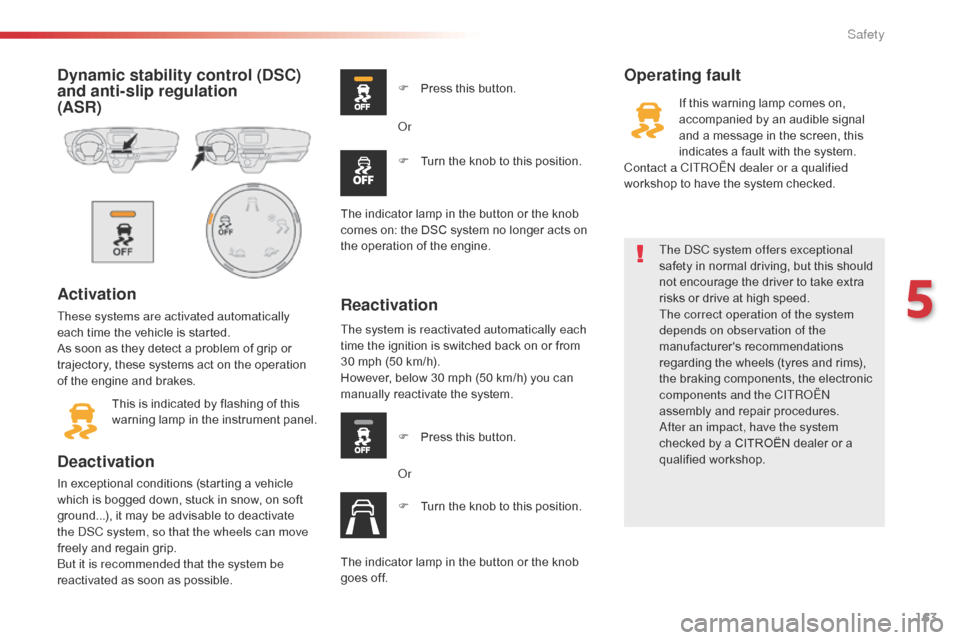
163
Jumpy _en_Chap05_securite_ed01-2016
Dynamic stability control (DSC)
and anti-slip regulation
(ASR)
Activation
These systems are activated automatically
each time the vehicle is started.
As soon as they detect a problem of grip or
trajectory, these systems act on the operation
of the engine and brakes.This is indicated by flashing of this
warning lamp in the instrument panel.
Deactivation
In exceptional conditions (starting a vehicle
which is bogged down, stuck in snow, on soft
ground...), it may be advisable to deactivate
the DSC system, so that the wheels can move
freely and regain grip.
But it is recommended that the system be
reactivated as soon as possible.
Operating fault
Reactivation
F Press this button. F
T
urn the knob to this position.
Or
The indicator lamp in the button or the knob
comes on: the DSC system no longer acts on
the operation of the engine. The system is reactivated automatically each
time the ignition is switched back on or from
30
mph (50 km/h).
However, below 30 mph (50 km/h) you can
manually reactivate the system. F
P
ress this button.
Or
F
T
urn the knob to this position.
The indicator lamp in the button or the knob
goes off. The DSC system offers exceptional
safety in normal driving, but this should
not encourage the driver to take extra
risks or drive at high speed.
The correct operation of the system
depends on observation of the
manufacturer's recommendations
regarding the wheels (tyres and rims),
the braking components, the electronic
components and the CITROËN
assembly and repair procedures.
After an impact, have the system
checked by a CITROËN dealer or a
qualified workshop.If this warning lamp comes on,
accompanied by an audible signal
and a message in the screen, this
indicates a fault with the system.
Contact a CITROËN dealer or a qualified
workshop to have the system checked.
5
Safety